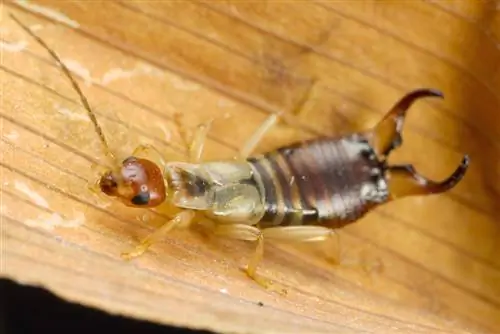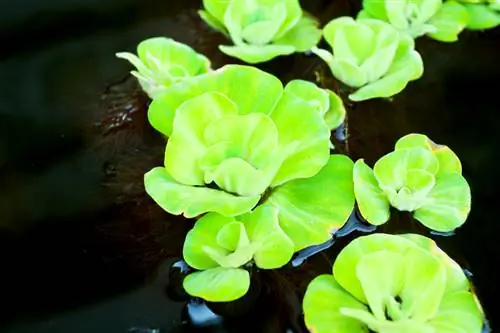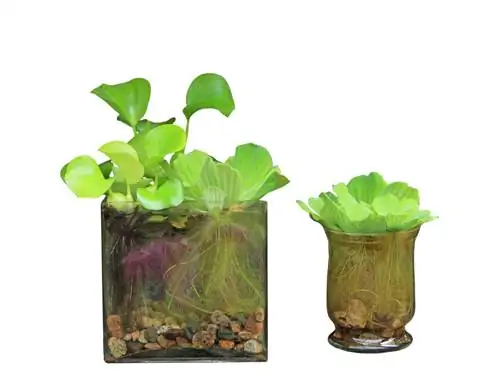- Author admin [email protected].
- Public 2023-12-16 16:46.
- Last modified 2025-06-01 06:02.
Earwigs don't have a good reputation. They are suspected of penetrating the ear canals and causing disgust. But the insects are by no means as bad as often assumed. If earwigs have settled in the garden, they can be used specifically as beneficial insects.
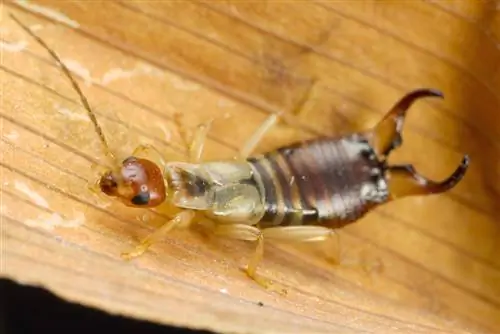
Earwig in the apartment
Earwigs, which represent the order of earwigs, are among the feared insects. There is great concern, especially when they are discovered in the apartment and house. In fact, the insects prefer a protected habitat in the garden. If earwigs suddenly appear in your own four walls, it is usually a coincidence.
Popular names:
- Ear lice or ear crawlers
- Earwigs, eared hyraxes and eared brooders
- Ohrawusler
Are earwigs dangerous?
In the past, the insect was considered dangerous to humans. Legend has it that the earwig nests in the ears of humans and pets and destroys the eardrum at night in order to lay its eggs there. In fact, the insects' mouthparts are not strong enough to eat through tissue.
Their pincers, which have developed from abdominal threads, are used to hunt small prey and for defense. If they feel threatened, they can nip with these so-called cerci. Such an earwig bite is neither poisonous nor dangerous and does not cause pain.
Useful or harmful?
The common earwig is considered an omnivore that feeds on both plant and animal food. It proves to be a beneficial insect because it eats aphids and caterpillars of various species of butterflies and curbs powdery mildew infestations. Earwigs utilize dead material and actively hunt smaller insects as predators. They are involved in the decomposition of dead biomass. The sand earworm is considered a pure carnivore and can be used for pest control.
In rare cases, the earwig appears as a pest. It mainly eats soft parts of plants such as flowers and tender vegetable sprouts. It cannot bite through hard leaf tissue and fruit skins. If the insect is observed on grapes or apples, then the fruit has been previously damaged by other insects. The earwig only uses the existing feeding passages, which come from codling moths and other insects.
Earwig in the apartment - cause
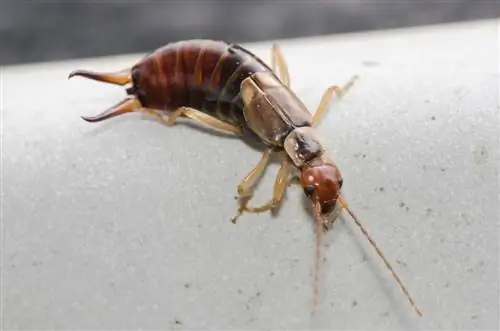
In search of a warm place to retreat, earwigs are sometimes drawn into the house
Earwigs prefer warm and slightly moist habitats. If you spot an earwig in the house, there is no need to panic. They like to hide in cracks and crevices, so they often find suitable places to retreat in window frames. In this way, the insects get into the apartment, which is not part of the optimal habitat. Various plants on the windowsill can attract insects through open windows and doors. Earwigs often get into the apartment through the soil in the flower pot.
- in the bathroom: Earwigs hide in freshly washed and slightly damp laundry
- in the kitchen: overripe fruit attracts insects
- in bed: warm and slightly damp conditions make an attractive shelter
Fighting earwigs
Normally there is no reason to fight earwigs. Since the insects develop a maximum of two generations per year, an earwig plague rarely occurs. The insects feel comfortable in garages, sheds and garden sheds or greenhouses. If you still want to get rid of the earwigs, we recommend taking gentle measures. Insect sprays, poison and other chemical agents are unnecessary.

It is neither necessary nor sensible to combat earwigs with chemicals. The insects are harmless and often very useful.
Earwig Trap
A trap is particularly effective if it corresponds to the optimal habitat conditions of the insects. The animals like it warm, somewhat damp and dark. They are active from dusk to night and go on raids under the cover of darkness. Leave the lights on at night to keep the earwigs in the trap. However, it can take a while for the animals to discover the roost. In the garden you can protect fruit trees with simple barriers.
| Prepare | Place | |
|---|---|---|
| Claypot | fill with wood wool, straw, newspaper | hang upside down in the kitchen |
| Fabric | moisturize | put in a corner of the room |
| Sticky trap | cut double-sided tape | gluing around fruit tree trunks |
Attract with home remedies
If you want to get rid of earwigs, you should attract the animals. A bundle of fresh lavender twigs is said to magically attract insects. They hide between the plant parts and can then be released outdoors. A bunch of brushwood also serves as an attractant, as earwigs like to retreat into such protected niches.

Preventing earwigs
With a few precautionary measures you can prevent earwigs from getting into your home. If you learn about the way these insects live, you will quickly realize the conditions in which earwigs thrive. For successful prevention, it is important that the environment appears unattractive to the insects.
Avoid fodder plants
There are a number of plants that earwigs prefer to eat. They do not belong to a specific plant family, but have particularly soft plant parts. Young plants or soft-shelled fruit such as apricots or grapes can also be eaten. To prevent insects from finding their way into your home, you should avoid these plants on the windowsill:
- Solanaceae: Angel's Trumpet
- Trumpet tree family: Trumpet flowers and trumpet trees
- Ranunculus: Clematis
- Asteraceae: Dahlias
- Orchids: thin-leaved species
Daily Routines
Before you bring in laundry from outside, it should be completely dry. Shake out bed sheets and towels thoroughly so that you don't bring earwigs into your home unnoticed. Air your bedding during the day and shake out your pillow and blanket outside. This allows moisture to evaporate and the laundry becomes unattractive to earwigs. Rooms containing linen and beds should be regularly heated and ventilated.
Inspecting flower pots
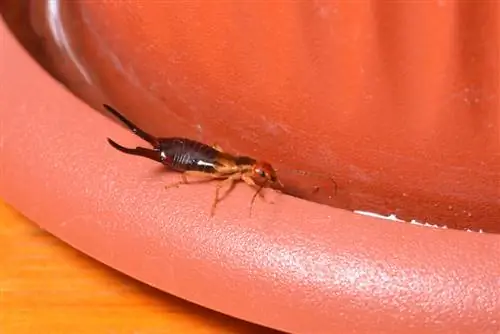
Flower pots are ideal for earwigs
Before you bring plants from the terrace and balcony into the house, you should take the root ball out of the pot. In this way, potential residents are scared away. If an earwig has settled in the substrate, you can watch the insect flee immediately. Then place the root ball in a bucket of water to wash out any insects hidden deep in the substrate.
Prepare windows and doors
Since earwigs feel comfortable in niches, you should close all possible entry points to your house and apartment from the outside. Use silicone or acrylic for facade holes and close door gaps with special bristle strips. Open windows and doors are protected from intruders by fly screens.
Profile
Earwigs are not beetles but an independent order and are therefore related to the beetles. Both orders are flying insects. The earwigs have the scientific name Dermaptera, which are represented by 1,800 species worldwide.
Reproduction
Earwigs display distinctive courtship behavior in which the males use their pincers. These are also used during mating to hold the female in place. After successful fertilization, this lays its eggs in spring and sometimes a second time in autumn.
She builds an underground nest to lay her eggs, or places her eggs in leaf grooves and under rotten bark. The females remain in the nest until the larvae hatch. Brood care mainly occurs in the spring generation. The female cleans and feeds the larvae throughout their month-long development.
What you need to know about the larvae:
- molt four to five times
- lighter colored than adult insects
- wingless
- overwinter only in adult stage
Earwig men always have this with them
The male earwigs have a main penis that can reach the length of the insect's body. When hardened, it can break out of the chitin shell and get stuck in the female's sexual duct. Theories suggest that the males want to impose a type of chastity belt on their female partners. These can then no longer mate with competitors. This loss doesn't bother the males much because they have a second replacement limb.
What do earwigs eat?
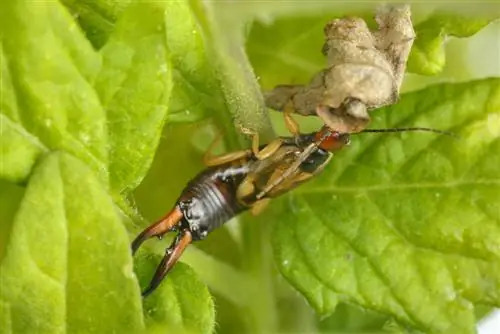
Earwigs eat aphids and other pests
Earwigs are omnivores and have not specialized in any particular food. They prefer aphids and their eggs and prey on other arthropods. Plant-based food is also on her menu. The insects attack soft plant tissue and eat young shoots or flowers of roses and other flowering plants.
They go for lettuce, celery or potatoes. Strawberries, peaches and grapes are not ignored. In addition, earwigs eat the dead and not yet broken down substance that accumulates on the ground. The insects also attack the collected supply of solitary bees, which store their food in earthen nests.
Can earwigs fly?
Earwigs are flying insects. You will rarely encounter a flying earwig because most species have atrophied flight muscles or incompletely developed wings. The common earwig has reduced wings to stubs, making it unable to fly. Winged insects have membranous wings beneath their short elytra that are intricately folded. In order to unfold these, the earwigs have to use their pincers.
Activity
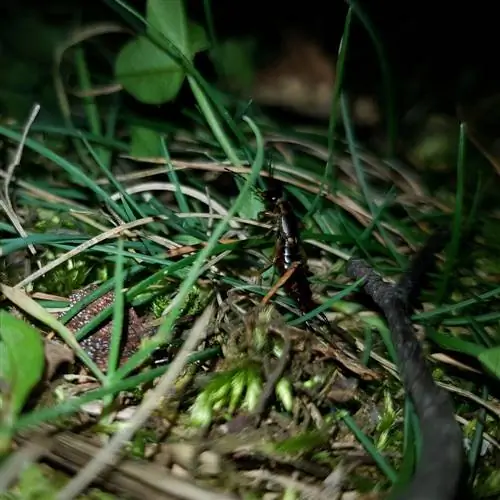
Earwigs are more active at night
Earwigs are mainly active during dusk and at night. They don't like daylight, which is why they rarely venture into lit rooms at night. During the day, earwigs hide in dark niches that are narrow and have slightly humid conditions. They form large accumulations under stones or rotten bark.
Thick branches or piles of leaves on the ground are also attractive hiding places. They like to retreat into hollow peach pits or abandoned bird nesting boxes. If you see an earwig during the day, it has most likely been disturbed.
Earwigs in medicine and popular belief
In ancient times, earwigs were used medicinally to treat ear diseases such as deafness. The insects were dried and processed into powder. The Latin name “auricula”, which means little ear, probably comes from this fact. The fairy tales about earwigs destroying eardrums may also come from the Middle Ages.
Recognizing species
Of the 1,800 known species of earwigs, ten representatives occur in Germany, because the insects, as cold-blooded animals, prefer warmer climates. Most species are extremely rare, so they are unlikely to find their way into your own garden. Only four species are considered common and are represented throughout Germany.
| German name | Occurrences | Frequency | |
|---|---|---|---|
| Euborellia annulipe | Southern Earworm | Saxony | rare |
| Euborellia arcanum | - | Saxony, Brandenburg | rare |
| Labidura riparia | Sandearwig | mainly northern and eastern Germany | scattered |
| Labia minor | Dwarf Earworm | almost throughout Germany | often |
| Paralabella curvicauda | - | Saxony | rare |
| Chelidurella guentheri | Forest Earwig | almost throughout Germany | often |
| Chelisurella thaleri | - | Bavaria | rare |
| Anechura bipunctata | Two-point earworm | Bavaria | rare |
| Apterygida media | bush earwig | almost throughout Germany | often |
| Forficula auricularia | Common catchy tune | Germany-wide | often |
Common catchy tune
The dark reddish-brown earwig is between ten and 16 millimeters long. The side of its body appears a lighter brown. The short cover wings are yellow-brown in color. The hind wings protrude slightly beneath them. Since the wings are greatly reduced, the common earwig is almost unable to fly.
The insect has a pair of pincers at the end of its abdomen, the base of which is colored light brown. Towards the tip the tools become dark brown. In males, the pincers are flat and slightly curved with one or two small teeth on the inside. Females have straight pincers that are shorter and finer than those of males.
bush earwig
With a body length of six to ten millimeters, this species is more delicate than the common earwig. The insect is finely hairy and has a shiny, dark brown to almost black head. Its wings are severely atrophied or are completely missing. The name comes from the preferred habitats in hedges and bushes. It needs caves in tree trunks or holes in the ground to lay its eggs. Its diet includes flowers and pollen from various shrubs, although the bush earwig also eats decaying plants and aphids.
Preferred habitats:
- Floodplain forests along bodies of water
- Parks and gardens in residential areas
- not too dry forest edges
- Bushes overgrown with hops and Virginia creeper
- in spring mainly blackthorn and hawthorn
- in the summer on flowering nettles
Forest Earwig
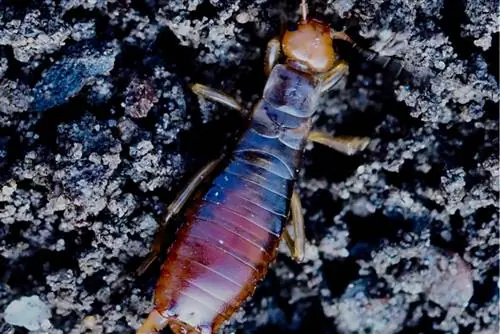
The wood earwig is widespread in our country
The species is between ten and fourteen millimeters long and has a predominantly brownish to black body. Its flanks appear light brown. Wood earwigs have no wings and their elytra are severely atrophied, which distinguishes them from other earwigs. Typical for males are the round pincers on the abdomen, which taper to a point in females. This species lives in deciduous and mixed forests, where it prefers to stay in fallen leaves. During the day the animal hides under stones and rotten bark.
Dwarf Earworm
This small insect appears dull brown with a yellowish tinge because its entire body is fine and densely hairy. The head and antennae are colored dark brown, with the tip of the antennae being slightly lighter. The abdomen has a reddish-brown base color. Compared to other common earwigs, this species has well-developed wings. With a body length of six to eight centimeters, the dwarf earwig is the smallest species.
Special features:
- preferably found on dung heaps
- As a good flyer, it also occurs far from suitable habitats
- eats plant juices, droppings, fly eggs and maggots
Tip
The dwarf earwig likes to fly on walls that have been painted with white lime paint. In the niches you have a good chance of observing the species.
Promoting earwigs in the garden
Earwigs are interesting and versatile insects that deserve a habitat in the garden. With an insect hotel you can introduce the earwig and thus increase the biodiversity in your own garden. This appeals to numerous insect eaters such as birds and hedgehogs, who like to eat earwigs as a treat.
A treat for natural enemies
If you encourage earwigs in your garden, you will also attract various insectivores. The animals are not only preyed on by ants, spiders and other predatory insects. Birds also like to peck the treats out of their hiding places and hedgehogs use the crawlers as a source of energy to prepare for the harsh winter. The pincers are of little use as a defense against such predators. Therefore, the earwig tries to defend itself with a secretion that is supposed to scare off the predator.
Excursus
Earwigs protect themselves with chemicals
Researchers from Giessen found that earwigs are continuously surrounded by a cloud of chemicals. This fine mist comes from the defensive secretion that the insects can secrete when threatened. The secretion can be fired at the enemy up to ten centimeters away. As a cloud of mist, it protects insects from fungi, bacteria and parasites. This defense mechanism is necessary because earwigs live in warm, humid and bacteria-friendly environments.
Building an Earwig Hotel

An earwig hotel attracts the beneficial insects and offers them protection
With a suitable nesting aid, you can encourage insects in your garden and thus benefit from the natural pest controllers. When the insects feel comfortable, the sociable animals reproduce regularly and form an entire colony. In the hotel they are protected from predators and can lay their eggs. You will need a classic clay pot with a drain hole or a ceramic vessel, filling material, grids or wooden sticks, wire and a string.
Construction instructions for a hotel made of ceramic or clay:
- Tie the string to a small wooden stick and pull it through the drain hole
- Fill the pot or container with straw, wood shavings, hay and a handful of soil
- Cover the opening with grid or wooden sticks and secure with wire
- Hang pot in trees with direct contact to the trunk
- alternatively place in beds
Tip
So that the filling material does not get wet when it rains, you can glue pottery shards to the drain hole before filling.
Turning earwigs into beneficial insects
If you have discovered a large colony of insects that has settled in an unfavorable location, you can attempt to relocate it. Place a bundle of hollow bamboo sticks near the colony and startle the animals with a light source. After a while, the earwigs have discovered the attractive hiding place and retreat into the narrow cavities. Carefully remove the bamboo sticks and hang them in plants that are preferentially attacked by aphids:
- Elderberry: Sambucus nigra
- Hibiscus: Hibiscus syriacus
- Snowball: Virbunum opulus and lanata
- False Jasmine: Philadelphus coronarius
- Roses: numerous types and varieties
Frequently asked questions
Do earwigs crawl into your ear?
The fact that earwigs prefer to penetrate the ears of sleeping people at night is a myth. Although it is possible that the insects occasionally crawl around on the human body, nesting in the ears is extremely unlikely and is more likely to be classified as accidental. This incident is most likely if you fall asleep in the tall grass of a flower meadow or in the hayloft in the barn. But here too, the earwig is not targeting the eardrum.
Why are earwigs called earwigs?
There are several theories about the origin of the name. In ancient times, insects were dried and pulverized. The powder was a remedy for various ear problems, which is reflected in the Latin suffix for the common earwig: auricularia means little ear. Other theories about the origin of the name refer to the shape of the pincers on the abdomen, which are often reminiscent of the eye of a needle.
Can earwigs pinch?
Earwigs are able to use their pincers as grippers. They use the tools for hunting and courtship. If they feel threatened and are picked up by humans, they may bite. In most cases, such a sting is completely painless. Earwigs are not dangerous. If you have been bitten by the earwig, you should clean and disinfect the wound.
What helps against earwigs?
If you want to get rid of catchy tunes, you don't have to resort to chemicals right away. There are gentler methods and natural remedies for earwigs in the home and garden. Hang a bundle of fresh lavender sprigs in the apartment and wait until the animals have nested in them. Alternatively, you can use a clay pot filled with straw and newspaper as a relocation aid. Release the insects away from your garden.
What do earwig men always have with them?
The males are equipped with a second penis, which researchers previously considered useless. The insects probably follow a special strategy in the wild. When mating, the males intentionally break off their body-length main limb so that the partner's sexual duct remains closed. Other males are no longer able to mate with the female.
How do I build an earwig trap?
You need a flower pot or an empty can. Fill the shelter with grass, hay, straw and crumpled newspaper. To prevent the filling from falling out of the container, place an elastic nest over the opening. The net of garlic bulbs, for example, is very suitable for this. The self-made insect hotel is hung upside down in trees and bushes that are often attacked by aphids. These serve as food for the earwigs.

